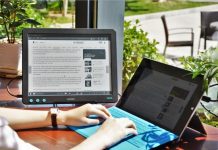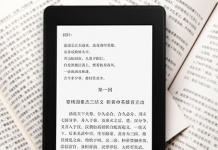 A friend lent me his Sony Reader for a couple of weeks. He wasn’t using it as much as he used to, so he wouldn’t miss it.
A friend lent me his Sony Reader for a couple of weeks. He wasn’t using it as much as he used to, so he wouldn’t miss it.
I received the device with a power adaptor and a minimum of instructions. There’s a school of thought that says that reading instructions is a waste of time anyway, and that interfaces should be intuitive and easy to grasp. I don’t subscribe to that philosophy, and not just because it displays a woeful lack of understanding of the way humans and interfaces work. There’s no such thing as “intuitive,” the best thing you can hope for is that an interface is analogous to interfaces you’ve used in the past.
The Sony Reader has no problems on that score. For me it was incredibly straight forward to operate. My friend had told me how to work the power button, and the rest I figured out by myself. I was up and reading within minutes.
The only thing I struggled with was the “Leave the book” function. For some reason it takes a few seconds to go from a novel’s page to Sony’s auto-generated “book cover.” I don’t know if this is a “feature” or if instead I did something wrong. The first few times it was irksome though, because I kept pressing the Up button, and the Reader remembered all those presses.
What the Sony is very good at is just displaying books. It starts up in a second, you can (fairly) quickly jump in and out of the books, there are several interfaces for sorting your library (by name, by date, et cetera), the device remembers where you were but you can also add bookmarks, and leafing between pages is quick enough to be painless. In other words, I never had the feeling I was operating a machine. I was always just reading.
The only time this idea of “just reading” broke down was when I wanted to take notes or search a book for a certain phrase. Lacking a keypad and a touch screen, there’s simply no way to do this with the Reader (to my knowledge—again, I never read the manual). It’s not that I always need to be able to take notes, but when I do the inability to do so is immediately noticeable. Indeed it is probably a testament to the immersiveness of the Reader and its like that getting up to look for pen and paper feels like just too much work.
There are two simple reasons why I wouldn’t buy this device. One is that I have been boycotting Sony ever since they tried to install malware on millions of computers. The other is simply a matter of pricing. I still believe that a digital book reader should cost around 50 bucks, be they euros or dollars. Plenty of Readers, Kindles and Iliads have been sold to prove that not everybody feels the same way I do though. The E Ink devices have clearly resonated with lots of bibliophiles, and now the wait is for the mystery device that will find and bind us all.
It would seem that reading habits are at the basis of a lot of reasons why people would buy one device and reject the other. In order for you to put my findings into context, here’s a list of mine.
- I am a voracious re-reader, and I keep books.
- I realized the other day that I often read books for their atmosphere, which may explain the re-reading. James Bond for instance is great if you want to get yourself in a go-get mood.
- I own a library that is small to book lovers but largish to the general populace (750+ copies).
- I do not suffer from “eye strain” or other fictional eye problems.
- My mind often wanders while reading—my biggest gripe with the 160×160 Palm Zire as a reading device is that I have to scroll back several “pages” before I get to the point where my mind forgot to warn my (browsing) thumb I had stopped paying attention.
- I take notes. Not always—I don’t generally write in books—but often enough that I notice it when I am not able to easily take notes.
- I read in bed a lot.
- I read a lot of second hand books.
And finally, I simply don’t have money for gadgets: if I buy a reading device, it must fill a real need. Perhaps I am atypical for a Teleread blogger in this respect, but with me it’s about the books and not so much the gadgets. If your reading habits map to mine though, if you figure Sony has gotten past its questionable ethics, and if you have the means, I highly recommend picking one up. A new version has been out for a while that apparently has a better screen.

































My pocketbook wishes that I had the kind of self-control you have in regards to gadgets. I have a Sony 505 and I still want a Cybook and a Kindle.
The Sony Reader is definitely not for scanning or note-taking. If I need to find a specific passage I will hook it up to my computer and search on-screen. I could definitely use a more responsive E-ink screen in the future. But for comfortable e-reading you really can’t beat the e-ink screen over a PDA or other backlits, unless you’re in bed, I can’t stand to get up and turn out a light or scoot to the lamp when I’m falling asleep reading, that’s when I use my old PDA.
I do not suffer from “eye strain” or other fictional eye problems.
I’m happy for you that you can read from backlit screens for a long time without discomfort. And I can see that if an e-ink screen isn’t a big plus for you, then a lot of the allure of a Sony or a Kindle goes away; reading on a backlit screen you already own is a much better deal than purchasing an expensive gadget for an e-ink screen.
That said, I’m not sure what you mean by “fictional” eye problems. When I’m tired, reading from a backlit screen makes my eyes hurt, and after a while I see two images, which get harder and harder to superimpose. I’m honestly not making it up. Whether that’s “eye strain” or not I don’t know, but it’s not imaginary.
Did you perhaps mean to use some other word?
I wasn’t going to jump on it, but since someone else called you on it, I’ll pile on too. Eye strain is a very real thing. I’ve had it just from *paper* books. I’ve had it from TV and computer screens. At one time I was using artificial tears to lube my eyes. Now, I must pull out reading glasses (soon, even for the computer screen; a prospect that horrifies me). I had absolutely excellent eyesight as a kid. I never, ever thought my eyes would become what they have.
That said, I enjoyed reading your impressions of the Sony Reader. I don’t understand you note fetishists, though!
“I don’t understand you note fetishists, though”
Here, here, Mike. Pausing to take down notes or highlight breaks up my concentration. I won’t take notes from a book for anything, I would never go back over them anyway.
I have a pen scanner. I’ve used it to grab well over 1MB of text from various books (never, btw, *complete* books; just paras or sentences). Argh, the pain. I’d wind up, like you, breaking my concentration.
And if I simply, uh, noted the page numbers to scan from later on, I’d never get to it because it felt like W-O-R-K.
What the heck do all these note people *note*, anyway? I can understand wanting to keep excerpts for reference … but what’s this note stuff all about?
Eye strain: I was being facetious and trying to draw out a response. Only later I realised that perhaps the subject was perhaps better suited for its own blog entry, which I am working on now.
Note taking: I don’t know where that comes from, with paper books I never take notes. I guess it’s because with a computer you can. E-book readers are computers. Also, having no way to input text stops me from searching. Again not a thing I’d ever do with printed books (how?), but somehow I feel I require this ability with e-books.